9 Brown Snakes In Florida
Spanning more than 65,000 square miles, Florida has a vast array of habitats that are home to many wonderful animals. Although the weather is hot and humid throughout most of the year, it has a rich and diverse ecosystem. One of the animals that thrive in Florida is snakes, and there are around 50 native species. Snakes come in virtually every color and size imaginable – from brightly colored coral snakes to snakes that blend in so well that you can barely see them. In fact, some of the best-camouflaged snakes are brown snakes which can blend in with the soil and leaf litter. So, join us as we discover nine of the brown snakes in Florida!
1. Southeastern Crown Snake

John Sullivan / Creative Commons – License
Southeastern crown snakes are endemic to the southeastern area of the United States. They are small snakes and are typically only 8 to 10 inches long. Southeastern crown snakes are usually light brown or greyish brown with black heads. Their heads are pointed, and they also have a light band of yellow or cream between their head and neck.
Southeastern crown snakes prefer habitats with sandy or loose soil and are often found underneath logs and rocks in woodlands. They produce a very mild venom which they use to subdue their prey – such as worms and spiders. The venom is delivered through small fangs at the rear of their upper jaw. Despite this, they are not aggressive and are not considered to be dangerous to humans. Their predators include kingsnakes and coral snakes.
2. Florida Pine Snake
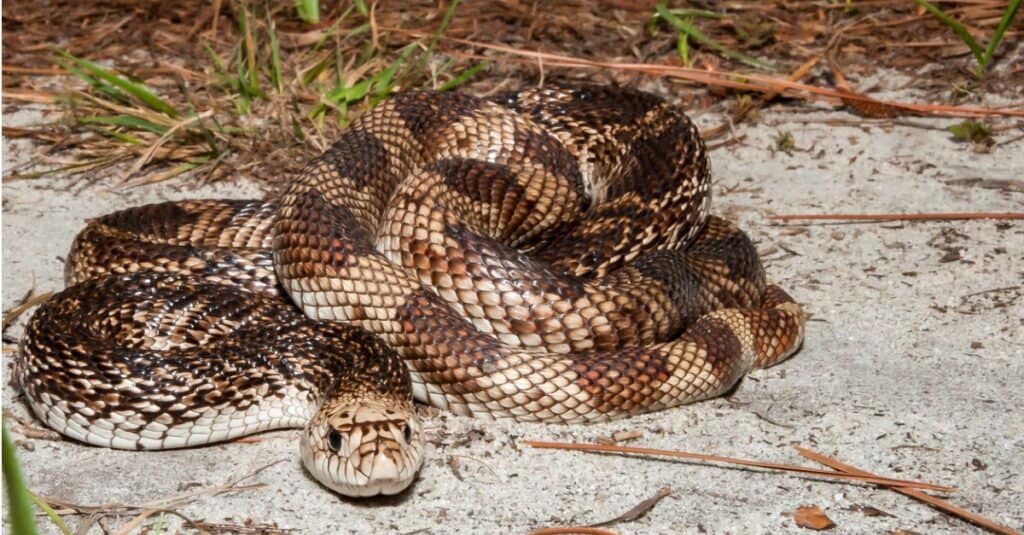
iStock.com/JasonOndreicka
Florida pine snakes, also known as pine snakes, are large, powerful snakes that can reach lengths of up to 90 inches. They are typically light brown with black, brown, or reddish-brown markings. They are native to several southeastern states, including Florida, and live in a range of habitats. Florida pine snakes are found at elevations of up to 9,000 feet in woodlands, prairies, rocky deserts, and brushlands. Areas with sandy soil are preferred as they often lay their eggs in burrows or under rocks. Pine snakes are non-venomous, and their diet includes rats, mice, moles, and voles. They often enter burrows in search of a meal and kill several rodents in one go in these cases.
3. Eastern Coachwhip
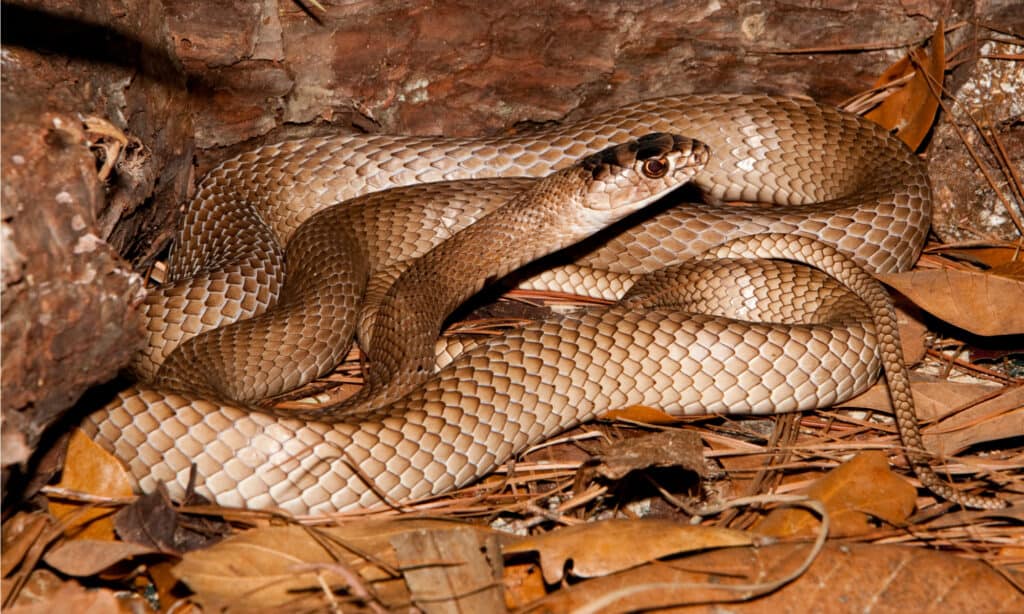
Jay Ondreicka/Shutterstock.com
Although there are six subspecies of coachwhip snakes, only the eastern coachwhip occurs in Florida. As their name suggests, they are long, slender snakes with thin bodies which can reach 72 inches long. Juveniles are typically brown or tan, while adults have a dark brown or black head and neck and bodies, which gradually become lighter to a pale tan color.
Eastern coachwhips live in various habitats, although pine woodlands, swamps, and marshes are favored. They prey on small birds, lizards, and rodents. They typically swallow their prey whole but sometimes beat them on the ground first to subdue them. Despite the myth that they attack people and whip them with their tails, eastern coachwhips typically flee quickly when disturbed.
4. Brown Water Snake
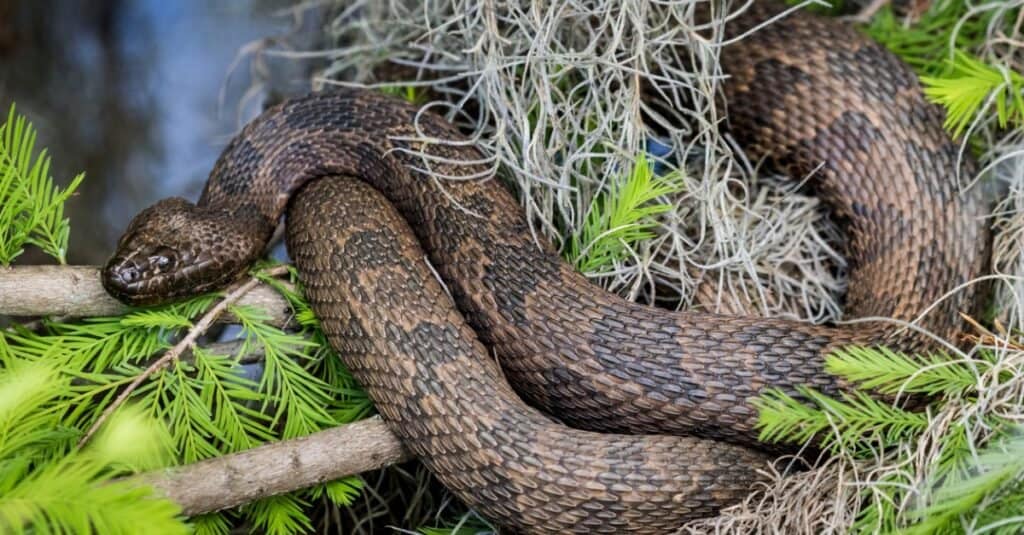
iStock.com/csraphotography
Brown water snakes are one of the most common species of water snake throughout the southeastern US, including throughout Florida. They live mainly in flowing water such as rivers, streams, and canals and feed on fish – particularly young catfish. However, they also sometimes live in swamps and brackish marshes. Brown water snakes are typically between 30 and 60 inches long, although a record length of 69 inches has been recorded. They are brown and usually have around 25 dark brown or black markings down their backs. Brown water snakes have heavy bodies and a neck that is significantly narrower than their head. Although they are a non-venomous species, brown water snakes can be extremely aggressive when threatened and can inflict a painful bite.
5. Florida Brownsnake
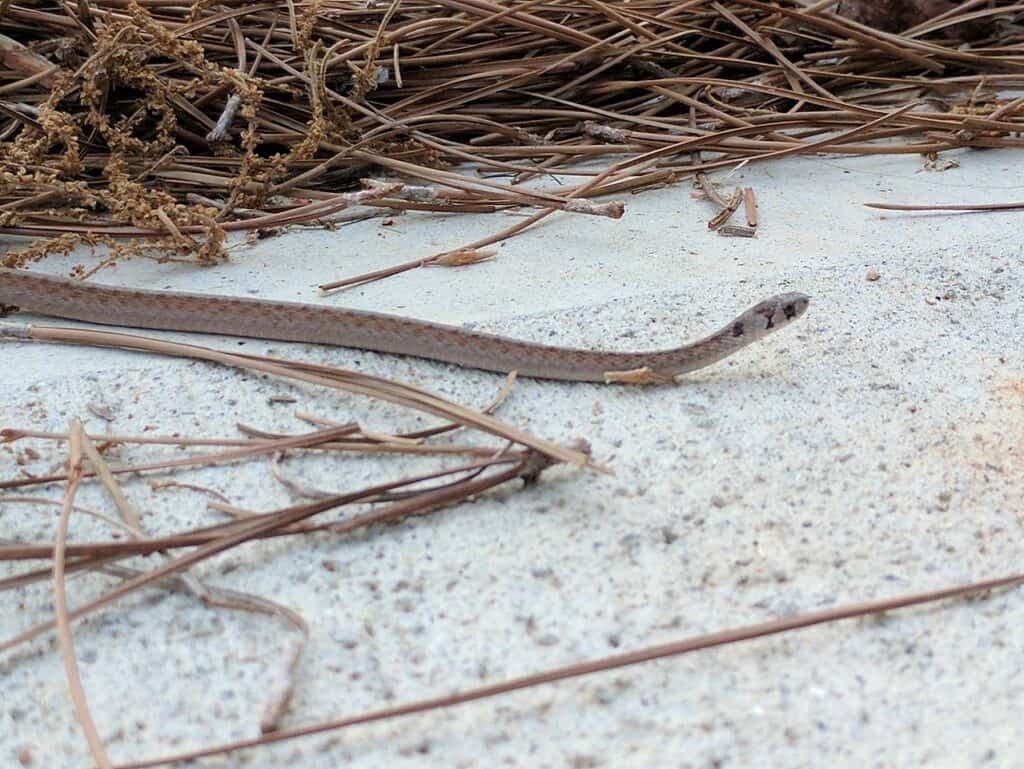
Sreejithk2000 / Creative Commons – License
Despite their name, Florida brownsnakes are endemic to both Florida and Georgia, where they live in various habitats. However, they are fairly secretive snakes and prefer to hide away underneath logs, rocks, and leaves. Florida brownsnakes are small snakes, ranging only between 9 and 13 inches long, with thin bodies. They are predominantly brown but have a light stripe running down the center of their backs with small black spots on either side. Florida brownsnakes are non-venomous and eat a mixture of earthworms, slugs, and insects.
6. Timber Rattlesnake

Scott Delony/Shutterstock.com
As one of many brown snakes in Florida, timber rattlesnakes are large pit vipers that are endemic to eastern North America. Their size ranges between 36 and 60 inches long, and they have a heavy, thick-set body. Timber rattlesnakes are usually yellowish or greyish brown, and they have dark brown or black crossband markings. Their tail is black and ends with a rattle which is typically held up above the ground. Timber rattlesnakes prefer damp fields and swamps but are occasionally found in urban areas. Timber rattlesnakes feed on small mammals, lizards, birds, and even other snakes. Although they are highly venomous, they are not particularly aggressive and typically attempt to flee, only striking as a last resort when threatened.
7. Eastern Diamondback Rattlesnake

Chase D’animulls/Shutterstock.com
Another venomous pit viper is the eastern diamondback rattlesnake, which is the largest species of rattlesnake in the world. Eastern diamondbacks are large, heavy snakes that typically reach between 33 and 72 inches, although a record of 99 inches has been achieved. These snakes have brownish bodies which are overlaid with large diamonds, hence their name. The diamond markings have dark-brown centers and cream-colored borders. The diamonds change to dark bands on the tail, which ends in a rattle that is usually held up in the air. Eastern diamondbacks live in pine woodlands and scrubland as well as coastal barrier islands. Although they are venomous and can strike at distances of up to 4 feet, they are not typically aggressive snakes. Their main diet is rabbits, rodents, and birds, and they usually ambush their prey.
8. Eastern Coppperhead

Jeff W. Jarrett/Shutterstock.com
Another brown snake in Florida is the eastern copperhead which is only found along the western tip of the Panhandle and along the Apalachicola River. Eastern copperheads are 22 to 36 inches long and live in deciduous forests and forests which border swampy, moist regions. Rocks and piles of logs and leaves are typically preferred as shelters. Eastern copperheads are pale tan and covered with light brown or sometimes gray crossbands. The pattern of crossbands along the back often gives them a distinctive hourglass shape, while the markings on their sides usually have light centers. Eastern copperheads tend to freeze rather than flee when disturbed, which is why they are often stepped on. Although they are venomous, they have some of the weakest venoms amongst all pit vipers. They also tend to do a “warning bite” first, which injects little to no venom.
9. Florida Cottonmouth
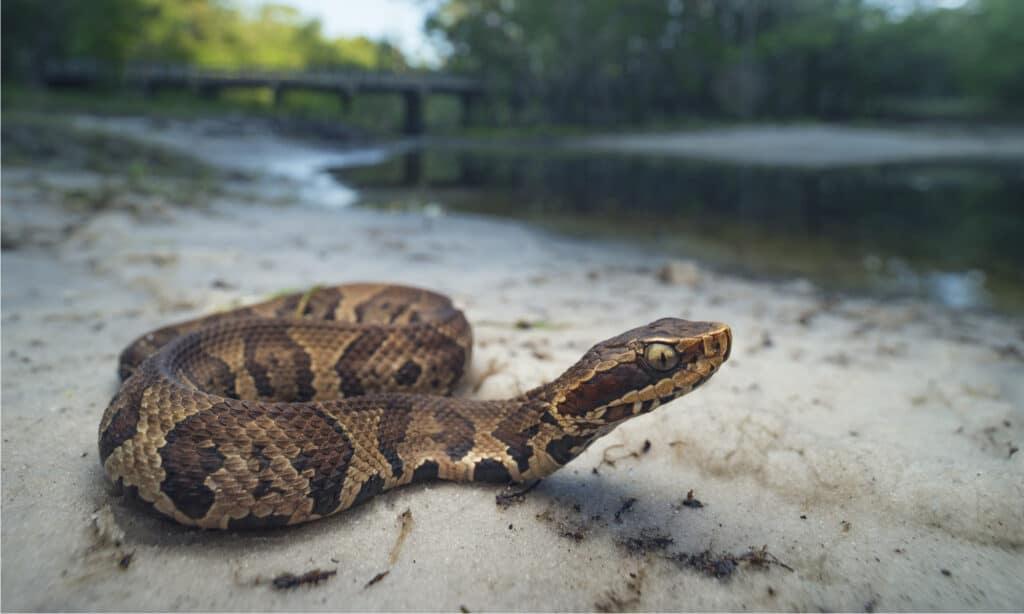
Kristian Bell/Shutterstock.com
Florida cottonmouths are widespread and are found in every county across Florida and many nearby islands. They live near every wetland habitat – including rivers, lakes, ponds, and swamps. However, they don’t rely entirely on water and can sometimes be up to one mile away from it. Florida cottonmouths are 30 to 48 inches long and have heavy bodies with a mixture of light and dark brown crossbands as well as several dark spots. They are venomous snakes but only strike as a last resort. When threatened, they tend to open their mouths, showing the white interior, which earned them the name “cottonmouth.” Florida cottonmouths are opportunistic feeders and eat a wide range of insects, fish, frogs, lizards, birds, and other snakes (even fellow cottonmouths).
Discover the “Monster” Snake 5X Bigger than an Anaconda
Every day A-Z Animals sends out some of the most incredible facts in the world from our free newsletter. Want to discover the 10 most beautiful snakes in the world, a “snake island” where you’re never more than 3 feet from danger, or a “monster” snake 5X larger than an anaconda? Then sign up right now and you’ll start receiving our daily newsletter absolutely free.
More from A-Z Animals
Spanning more than 65,000 square miles, Florida has a vast array of habitats that are home to many wonderful animals. Although the weather is hot and humid throughout most of the year, it has a rich and diverse ecosystem. One of the animals that thrive in Florida is snakes, and there are around 50 native species. Snakes come in virtually every color and size imaginable – from brightly colored coral snakes to snakes that blend in so well that you can barely see them. In fact, some of the best-camouflaged snakes are brown snakes which can blend in with the soil and leaf litter. So, join us as we discover nine of the brown snakes in Florida!
1. Southeastern Crown Snake

John Sullivan / Creative Commons – License
Southeastern crown snakes are endemic to the southeastern area of the United States. They are small snakes and are typically only 8 to 10 inches long. Southeastern crown snakes are usually light brown or greyish brown with black heads. Their heads are pointed, and they also have a light band of yellow or cream between their head and neck.
Southeastern crown snakes prefer habitats with sandy or loose soil and are often found underneath logs and rocks in woodlands. They produce a very mild venom which they use to subdue their prey – such as worms and spiders. The venom is delivered through small fangs at the rear of their upper jaw. Despite this, they are not aggressive and are not considered to be dangerous to humans. Their predators include kingsnakes and coral snakes.
2. Florida Pine Snake

iStock.com/JasonOndreicka
Florida pine snakes, also known as pine snakes, are large, powerful snakes that can reach lengths of up to 90 inches. They are typically light brown with black, brown, or reddish-brown markings. They are native to several southeastern states, including Florida, and live in a range of habitats. Florida pine snakes are found at elevations of up to 9,000 feet in woodlands, prairies, rocky deserts, and brushlands. Areas with sandy soil are preferred as they often lay their eggs in burrows or under rocks. Pine snakes are non-venomous, and their diet includes rats, mice, moles, and voles. They often enter burrows in search of a meal and kill several rodents in one go in these cases.
3. Eastern Coachwhip

Jay Ondreicka/Shutterstock.com
Although there are six subspecies of coachwhip snakes, only the eastern coachwhip occurs in Florida. As their name suggests, they are long, slender snakes with thin bodies which can reach 72 inches long. Juveniles are typically brown or tan, while adults have a dark brown or black head and neck and bodies, which gradually become lighter to a pale tan color.
Eastern coachwhips live in various habitats, although pine woodlands, swamps, and marshes are favored. They prey on small birds, lizards, and rodents. They typically swallow their prey whole but sometimes beat them on the ground first to subdue them. Despite the myth that they attack people and whip them with their tails, eastern coachwhips typically flee quickly when disturbed.
4. Brown Water Snake

iStock.com/csraphotography
Brown water snakes are one of the most common species of water snake throughout the southeastern US, including throughout Florida. They live mainly in flowing water such as rivers, streams, and canals and feed on fish – particularly young catfish. However, they also sometimes live in swamps and brackish marshes. Brown water snakes are typically between 30 and 60 inches long, although a record length of 69 inches has been recorded. They are brown and usually have around 25 dark brown or black markings down their backs. Brown water snakes have heavy bodies and a neck that is significantly narrower than their head. Although they are a non-venomous species, brown water snakes can be extremely aggressive when threatened and can inflict a painful bite.
5. Florida Brownsnake

Sreejithk2000 / Creative Commons – License
Despite their name, Florida brownsnakes are endemic to both Florida and Georgia, where they live in various habitats. However, they are fairly secretive snakes and prefer to hide away underneath logs, rocks, and leaves. Florida brownsnakes are small snakes, ranging only between 9 and 13 inches long, with thin bodies. They are predominantly brown but have a light stripe running down the center of their backs with small black spots on either side. Florida brownsnakes are non-venomous and eat a mixture of earthworms, slugs, and insects.
6. Timber Rattlesnake

Scott Delony/Shutterstock.com
As one of many brown snakes in Florida, timber rattlesnakes are large pit vipers that are endemic to eastern North America. Their size ranges between 36 and 60 inches long, and they have a heavy, thick-set body. Timber rattlesnakes are usually yellowish or greyish brown, and they have dark brown or black crossband markings. Their tail is black and ends with a rattle which is typically held up above the ground. Timber rattlesnakes prefer damp fields and swamps but are occasionally found in urban areas. Timber rattlesnakes feed on small mammals, lizards, birds, and even other snakes. Although they are highly venomous, they are not particularly aggressive and typically attempt to flee, only striking as a last resort when threatened.
7. Eastern Diamondback Rattlesnake

Chase D’animulls/Shutterstock.com
Another venomous pit viper is the eastern diamondback rattlesnake, which is the largest species of rattlesnake in the world. Eastern diamondbacks are large, heavy snakes that typically reach between 33 and 72 inches, although a record of 99 inches has been achieved. These snakes have brownish bodies which are overlaid with large diamonds, hence their name. The diamond markings have dark-brown centers and cream-colored borders. The diamonds change to dark bands on the tail, which ends in a rattle that is usually held up in the air. Eastern diamondbacks live in pine woodlands and scrubland as well as coastal barrier islands. Although they are venomous and can strike at distances of up to 4 feet, they are not typically aggressive snakes. Their main diet is rabbits, rodents, and birds, and they usually ambush their prey.
8. Eastern Coppperhead

Jeff W. Jarrett/Shutterstock.com
Another brown snake in Florida is the eastern copperhead which is only found along the western tip of the Panhandle and along the Apalachicola River. Eastern copperheads are 22 to 36 inches long and live in deciduous forests and forests which border swampy, moist regions. Rocks and piles of logs and leaves are typically preferred as shelters. Eastern copperheads are pale tan and covered with light brown or sometimes gray crossbands. The pattern of crossbands along the back often gives them a distinctive hourglass shape, while the markings on their sides usually have light centers. Eastern copperheads tend to freeze rather than flee when disturbed, which is why they are often stepped on. Although they are venomous, they have some of the weakest venoms amongst all pit vipers. They also tend to do a “warning bite” first, which injects little to no venom.
9. Florida Cottonmouth

Kristian Bell/Shutterstock.com
Florida cottonmouths are widespread and are found in every county across Florida and many nearby islands. They live near every wetland habitat – including rivers, lakes, ponds, and swamps. However, they don’t rely entirely on water and can sometimes be up to one mile away from it. Florida cottonmouths are 30 to 48 inches long and have heavy bodies with a mixture of light and dark brown crossbands as well as several dark spots. They are venomous snakes but only strike as a last resort. When threatened, they tend to open their mouths, showing the white interior, which earned them the name “cottonmouth.” Florida cottonmouths are opportunistic feeders and eat a wide range of insects, fish, frogs, lizards, birds, and other snakes (even fellow cottonmouths).
Discover the “Monster” Snake 5X Bigger than an Anaconda
Every day A-Z Animals sends out some of the most incredible facts in the world from our free newsletter. Want to discover the 10 most beautiful snakes in the world, a “snake island” where you’re never more than 3 feet from danger, or a “monster” snake 5X larger than an anaconda? Then sign up right now and you’ll start receiving our daily newsletter absolutely free.







